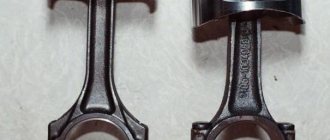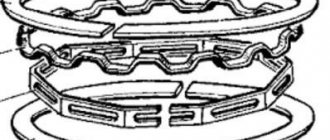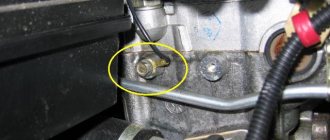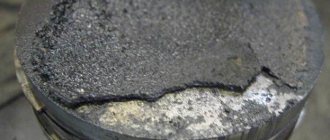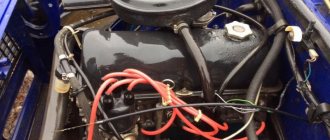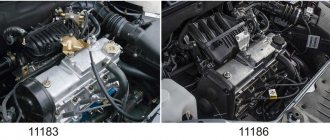When I first heard about such a popular garage name as non-stick pistons, a lot of things turned around in my head in search of the correct answer that determines their pragmatic use, but for some reason it never came to mind... Finally, turning to the Internet, I found nevertheless, information that these are essentially the same pistons that have grooves to prevent the valves from bending and breaking if the timing belt suddenly breaks. Actually further, all those who know what they look like and how it all works don’t have to read, but I will analyze the topic in more detail, for those who do not know about this issue.
Why do engines bend valves?
One of the ways to increase engine power is to ensure the most efficient filling of the combustion chambers with the air-fuel mixture and removal of exhaust gases. And this is done in two ways - by increasing the number of valves per cylinder and increasing the throughput of the intake and exhaust ports.
The second method is implemented by increasing the distance where the valve exits the seat, and this is what causes it to collide with the piston with subsequent bending.
Thanks to the drive of the gas distribution mechanism from the crankshaft, synchronous operation of the timing belt and crankshaft is ensured. During normal operation of the power unit, as the piston approaches TDC, the valves are in the closed position, which prevents their contact.
If the drive of the gas distribution mechanism is broken, the connection between the mechanisms is lost, and the timing belt immediately stops, and the crankshaft continues to function (due to the inertia of the flywheel). In this case, the return valve springs set the camshaft in a position in which most of the cams of the shaft do not press on the valves (they are closed), but some of them still rotate so that they act on the valves and the latter are open.
In “non-plug-in” engines, it is structurally designed to maintain the distance between the valve plate and the piston bottom located at TDC, so even with the valves open, contact does not occur.
On these power plants, a break in the gas distribution mechanism drive does not lead to any internal damage to components and parts, and to restore the operation of the power unit it is enough to install a new belt and perform adjustment work (align everything according to the marks).
But if the power plant is “plug-in”, strongly protruding valves collide with the piston, which leads to their bending. On such engines, timing drive failure is usually accompanied by a strong single knock. Engine repair in this case is labor-intensive and expensive, since damaged parts have to be replaced and the cylinder head restored.
On VAZ power units that are susceptible to valve bending when the drive breaks, it is especially important to timely replace the timing belt and periodically diagnose its condition, check and adjust the tension. Such measures are practically the only way to prevent valve failure.
Price issue
As for the cost of work, the spread here is very large. In the Moscow region, depending on the service, repairing such a VAZ engine will cost from 15,000 to 40,000 rubles.
To “bring to mind” the VAZ-21116 engine, you will have to spend time searching for spare parts and a decent amount of money. But if the plug-in engine has already failed - and this can happen to it anytime, anywhere - such a modification is guaranteed to save you from repeating a similar situation and all possible consequences.
Send all questions and suggestions regarding the “Technical Environment” series of issues to
Other episodes of “Technical Environment” are available in our special project, as well as on our YouTube channel.
Source
VAZ engines – “non-stick” and “risky”
Since several power plants are installed on each of the VAZ models, it is important to know which of them are “plug-in”. As already noted, on the classic VAZ (2101-2107) and VAZ Niva, power units were installed in which the valves bend
But since the timing drive on these engines is a chain drive, “butt-in” can not be taken into account
As already noted, the classic VAZ (2101-2107) and VAZ Niva were equipped with power units in which the valves bend. But since the timing drive on these engines is a chain drive, “stick-in” can not be taken into account.
"Samara"
The following were installed on cars of the Samara family (VAZ 2108-21099):
- Units marked VAZ 21081, 2108 (carburetor and injection);
- Motors 21083, 21091;
- 8-valve VAZ-2111 (models of later years of production).
Of these, units 21083 and 2111 did not bend the valves when the timing belt broke, but versions 21081 and 2108 were “risky”.
VAZ 2110-2112
On models of the 10th family (VAZ-2110-2112), the range of power plants is even more extensive. Some units were installed on all cars of this family, while some were offered only for certain models.
Common to all models were engines with the indexes VAZ-2110, 2111 (8-valve), 2112, 21114, 21124. Of these, the VAZ-2112 and 21114 engines are “plug-in”, and the remaining valves do not bend.
Additionally, the VAZ-2112 model car was equipped with a VAZ-21128 power unit, which is also “risky” and bends the valves when the timing belt breaks.
"Samara-2"
Cars of the Samara-2 family, which includes the VAZ 2113-2115 models, are equipped with units of the VAZ-2111, 21114, 21124 and 21126 brands. Of these, only VAZ-2111 and 21124 engines are “risk-free”.
Also for the VAZ-2113 and 2115 versions, a motor with index 11183 was offered, in which a broken belt does not lead to bending of the valves.
"Granta", "Kalina", "Priora"
The Lada Granta is equipped with a line of units of the following brands: 11183, 11186, 21126 and 21128. The last two of them are also equipped with the Granta Sport version. Of all the engines, only version 11183 is “non-plug-in”, the rest have bent valves.
For the Lada Kalina, engines of the VAZ brands 11183, 11186, 11194, 21126 and 21127 are offered. The last two units are also installed on the Kalina Sport model, and the Cross version is equipped with engines 21127 and 11186. Of the entire line, only the VAZ-11183 engine does not bend valves when the timing belt breaks.
Lada Priora is equipped with units with indexes 21114, 21116, 21126 and 21127. All these engines are plug-in.
Please note that only the main brands of power plants that are equipped with certain models are listed above. But AvtoVAZ almost always “sins” with experimental small-scale production, when units that are uncharacteristic for it are installed on some cars.
For example, the VAZ-2109 was equipped with an engine with an identical index, which differed from the 2108 version in a lightweight design, and the small VAZ-2108 series was even equipped with a rotary unit labeled VAZ-415.
READ ON THE TOPIC: Other characteristic malfunctions of the VAZ 2110 and other models of the series.
AvtoVAZ modified 1.6-liter engines to prevent valve bending, new details
On modern VAZ engines, when the timing belt breaks, the valves “meet” the piston, which causes critical damage and requires expensive repairs. In this regard, AvtoVAZ decided to modernize its line of engines by installing new pistons that will eliminate such damage, writes CARscope.ru, citing its sources.
The plant's supplier, Federal Mogul, has mastered the production of pistons with recesses (holes, counterbores) in the bottom. Motors with such pistons are popularly called “plug-free”, that is, when the timing belt breaks, the valves do not “plug” into the pistons, the bottoms of which have special grooves for this case.
The new piston group is designed for a range of 1.6-liter engines that are installed on the Lada Granta, Kalina, Largus, Vesta, XRAY models:
- VAZ-11186 (8 cells, 87 hp)
- VAZ-21126 (16 cells, 98 hp)
- VAZ-21127 (16 cells, 106 hp)
- VAZ-21129 (16 cells, 106 hp)
For the 1.8-liter engine with the VAZ-21179 index, a modified piston group is not provided.
Update 08/29/18
: The day before the opening of MIAS-2018, AvtoVAZ representatives presented the updated Lada Granta family to the media. Now, on all Granta engines - both 8-valve and 16-valve - they use “stickless” pistons, that is, with grooves where the valve “falls” if the timing belt breaks, and the piston pushed up by inertia will go to it towards. Nikita Gladky (product manager) told Kolesa.Ru about this.
Update 09/04/18
: The website Lada.online clarified the information in the official LADA group on VK. Answer:
To the question “both Vesta and XRAY with 1.6 liter?” They answered like this:
Later, AvtoVAZ customer service reported:
Lada Largus also received such an engine modification, because This car is equipped with similar 1.6-liter engines.
Update 09/06/18
: A slide titled “Engine piston design change” has leaked online. It states that new pistons are used for all engines (only 1.6-liter engines are shown in the photo). The holes in the bottom of the piston for the full stroke of the valves eliminate the possibility of sticking the valves into the piston if the timing kinematics are disrupted (for example, if the belt breaks).
A new coating and a change in the side profile of the piston skirt made it possible to increase the wear resistance of the pistons and, as a result, reduce the tendency of engines to knock and increase fuel consumption.
Do you want to see this modification on 1.8-liter engines? This will happen if the brand “sees a clear request from the consumer,” who “has not yet expressed such wishes.” Simply put, if you want to get a “no problem”, write letters to the factory. This was reported to auto.mail.ru by Sergey Kornienko, head of the Lada brand product portfolio development department.
According to unofficial information, “stickless” pistons began to be installed from engine number 3920500.
Update 09/16/19
: A source directly related to the production of VAZ 21179 engines sent us a photo and told us some more details:
Source
Domestic 16-valve engines
A little preface. When faced with 16-valve VAZs at the household level, remember that such cars are always equipped with 14-inch wheels, since there are enlarged ventilated brake discs at the front.
So, the “gear” came from an 8-valve engine. In the articles you can find mentions that VAZ wanted to create a powerful and economical engine, and so, the “gear” will never be more economical than an eight-valve engine. Consumption 16 cl. engine 7.5 - 10 liters, depending on the dynamics.
The first engine from the line was 21120 (hereinafter referred to as the 120th
). The volume is one and a half liters, equipped with an ignition module, the valves bend. Visually different is the cast intake manifold. It was developed for cars 2110-2112, installed in various modifications such as “Premier” and 2112 in a two-door hatchback body. It went into production in 1996 and was installed on cars until 2004. If today you buy a car with such an engine, then most likely it has already undergone repairs and a “plug-in” piston is installed on it.
In 2004, the 120th engine was replaced by a new one with the index 21124 (hereinafter referred to as the 124th
). In addition to cars of the tenth family, it was installed on the VAZ 2113 and VAZ 2114.
This engine does not bend the valves, thanks to grooves on the pistons, this is its main difference from its predecessor. It is easy to distinguish by its plastic intake manifold. In addition, the ignition module has been replaced with individual coils for each cylinder. Engine capacity increased to 1.6 liters.
Many people call this engine the most balanced in the VAZ line, and I think this is true. Its service life is at least 200 thousand, if you drive “without fanaticism”.
In 2007, the tenth family left the assembly line (the vehicle kits were sent to Ukrainian as punishment) and the Priora was released. This “breakthrough” in mechanical engineering was equipped with the 21126 engine ( 126th
). It was equipped with lightweight connecting rods, pistons, liners, and other parts, which made its service life less than that of a 124 engine. In order to increase power, the grooves on the pistons have been removed and the valves on this engine are bent.
21128 or 128th
the motor was created and installed on Priora and 2110-2112, which were produced by this company. This is the heir to the 124th engine, the engine capacity has been increased to 1.8 liters, which has a negative impact on the service life. In practice, I saw one such car, which, with a mileage of 90 thousand kilometers, suffered from severe oil consumption. This engine received a lot of negative reviews.
In 2013, 21127 appeared or 127
-th engine, its power was increased to 106 horsepower, an adjustable air intake through the receiver was installed, the mass air flow sensor was abandoned in favor of the DBP (absolute pressure sensor) and the DTV (air temperature sensor). The valves in this engine are bent.
And the last creation we will look at is this 11194
engine. It has a volume of 1.4 liters, installed on Kalina. At one time I drove such a Kalina, and the meaning of such an engine is not clear to me; it drives exactly the same as an 8-valve one. The reviews leave much to be desired, and for its unjustified oil consumption, the engine was nicknamed the “legendary Kalinomotor”, of course, not without sarcasm.
We briefly looked at the "six" from VAZ. In this article I will not touch on modern Vest engines and other creations of AVTOVAZ; to be honest, I’m losing interest in studying the crafts of the alliance of the French and Japanese.
If the article was interesting, then give it a thumbs up and subscribe to the channel.
Source
What do stickless pistons mean?
Well-known member
To call them plug-free is not literary, but in a “garage” way - they will immediately understand you and appreciate your technical potential! This name comes from a simple trick - the piston does not meet the valve using a special groove on top - that is, the valve DOES NOT STICK into the piston, that's the name. However, if you tell it technically and literary correctly, it turns out that there are several grooves in the upper part of the piston. Their number can be different - from 2 to 4 pieces. It is thanks to these grooves that these two engine elements do not meet. That is, the correct name is a piston with grooves.
Pros:
If your timing belt and overhead camshaft with a set of valves breaks, they freeze in place. If the piston comes from below, pushed by the crankshaft, then no disaster will happen - they will simply fall into the grooves and everything will be fine. That is, we just take the car to the service station, they restore the timing mechanism and you drive on. A VERY big plus.
Minuses:
1) The piston with a groove cannot be called light! In order to go deeper in the top (to make grooves) you need to have a thick top, which significantly makes the piston heavier, which consequently removes power.
2) Also, the grooves have a bad effect on the compression of the fuel mixture. Which also “eats” power. In general, to summarize, installing such a piston will take away the same 5 - 7% of its power from the engine. Now imagine, if the engine is 150 hp, installing such options will take 10.5 hp away from it.
3) Another disadvantage is higher fuel consumption, since the volume of the chamber is increased - albeit by a little, but still.
4) Compression also decreases due to the larger volume.
5) Detonation also increases due to the less uniform distribution of the piston weight.
So many manufacturers refuse such an idea, all for the sake of productivity, efficiency and elasticity of the units. Here, as they say, you need to choose - either maximum performance or security.
Source
Installation on PRIORU
As promised, I will describe the installation on our VAZ (PRIORA), because it is one of the most purchased cars in our country and it has frequent problems with the timing belt. Many will immediately ask the question - do the valves bend when they break? Read the answer here.
In principle, no difficulties should arise here, but it is practically impossible to do this yourself in your yard! The engine will need to be disassembled.
1) We buy plugless pistons; usually the kit can be selected directly to your piston size. That is, if you have an 86 mm piston, then you can also take a plugless piston of 86 mm. However, you need to either know the exact dimensions, or measure them at a service station during disassembly. The cost can vary from 3,000 to 6,000 rubles per set.
2) We disassemble the engine to remove the pistons; it may need to be removed. (Of course, you don’t have to remove it, this is at the discretion of the masters, there are methods both ways)
3) Remove the piston group and replace it with grooved pistons.
4) Next we assemble the engine
5) Let's go.
Many drivers sacrifice power for the sake of greater practicality - you can understand them, especially if you look at the aftermarket. If there is a break, you can fly into such repairs that it won’t seem like much, but this way you are protected.
Let's watch a short but useful video on the topic.
I will finish, I think you liked the continuation of the article. Read our AUTOBLOG, updates almost every day.
Similar news
- Do-it-yourself windshield polishing. In different ways + pass...
- How to check the adsorber valve. On our VAZs
- Different compression in the cylinders. Why and what to do? Let's figure it out...
Add a comment Cancel reply
Subtleties of ShPG
Let's move on to the most interesting part - the connecting rod and piston group. On our plug-in engine, the pistons do not have grooves for the valves. We decided to replace the pistons with new ones, with grooves, and together with the connecting rods, since the old ones were bent. We ordered spare parts from the official dealer Federal Mogul. The kit for one cylinder includes a piston, rings, a pin and the connecting rod itself, along with bolts for securing the lower cover of its head. Grooves are visible on the bottom of the pistons, as well as the number 11189, an arrow indicating the direction of installation of the piston in the cylinder block, and the production date. The skirt has an improved iron oxide coating to protect it from damage.
How to replace pistons
This is a fairly serious operation that fits into the category of a major overhaul. It requires the application of both skill and simply physical strength. In addition, there is a fairly large volume of tools and devices. What a repairman will need:
- Replacement pistons set with rings.
- Pins and stops.
- Crankshaft oil seals.
- Complete locksmith set of keys.
- Retaining ring removers.
- Hammer and punch.
- Engine oil.
- Containers for oil and antifreeze.
- Clean rags.
Some aspects will be mentioned briefly as they are described in separate articles. So.
The work is best done on a stationary lift. As a last resort, in a well-equipped inspection pit.
Using containers, drain the antifreeze and oil from the crankcase. These details are described in some detail in separate articles. As well as removing the gearbox. Which is the next step. After removing the box, it’s time to work on the motor.
The generator belt is released and unscrewed using the 17 head for the damper mounting bolt. When removing the damper, it must be checked to see if it needs to be replaced. Remove the cover and, in sequence, the timing belt and crankshaft gear. Now remove all the bolts holding the oil pan. Remove the oil intake. Now access to the crankshaft is completely open. Using a wrench, unscrew the 10 bolts securing the journals of the 5 main bearings and set them aside.
Special attention! The inserts must be folded in the order in which they were installed. It’s best to mark them with a marker so you don’t accidentally replace them, and then install them in the reverse order. Everyone in their place. Otherwise, you can get premature wear on the crankshaft surface, which will lead to its replacement.
Once the fasteners are removed, you can finally remove the crankshaft assembly with pistons and connecting rods for replacement. Transfer it to a clean surface and wipe with a rag. Using a puller, pull out the retaining rings of the piston pins, then carefully, using a drift, knock out the pins and remove the pistons.
Replace all pistons in the group. Install new pistons in place according to the marks. Insert fingers and secure with rings. Reassemble everything in reverse order, paying special attention to the order in which the neck liners are installed. Reinstalling the timing belt is a very important operation, and there is a separate article on its implementation. Replace the crankshaft oil seals. Add oil and antifreeze and you can try starting it.
Replacing Priora pistons during tuning
There are no special features here, except for the uniqueness of the pistons themselves. They usually have a shorter skirt and slight design differences. They all boil down to increasing engine power. But most importantly, they must have grooves for the valves. This is an indispensable condition when choosing a replacement. Sometimes they are called "turbo pistons". But this is already a specialization of young “racing drivers” and mechanics serving this category.
Decoding of the index in the name of the AvtoVAZ engine
At first, the internal combustion engine index was tied to the car model on which it first appeared.
Now the concern has formed a unique system for naming its units:
First two digits
11 or 21 means the number of the workshop where their assembly was established
Third digit
here it acts as a separator and for now it is always equal to one
Fourth digit
indicates the number of valves: 1 and 8 are 8v, and 2, 7 and 9 are 16v
Fifth digit
reports the position of the internal combustion engine in the series and the larger it is, the newer the engine
You can contact the site administrator by email:
All texts were written by me, are authored by Google, included in the original Yandex texts and notarized. For any borrowing, we immediately write an official letter on company letterhead in support of search networks, your hosting and domain registrar.
Next we go to court. Don’t try your luck, we have more than thirty successful Internet projects and have already won a dozen lawsuits.
Source
Subtleties of ShPG
Let's move on to the most interesting part - the connecting rod and piston group. On our plug-in engine, the pistons do not have grooves for the valves. We decided to replace the pistons with new ones, with grooves, and together with the connecting rods, since the old ones were bent. We ordered spare parts from the official dealer Federal Mogul. The kit for one cylinder includes a piston, rings, a pin and the connecting rod itself, along with bolts for securing the lower cover of its head. Grooves are visible on the bottom of the pistons, as well as the number 11189, an arrow indicating the direction of installation of the piston in the cylinder block, and the production date. The skirt has an improved iron oxide coating to protect it from damage.
The lower head of the connecting rod is made using breaking technology, due to which the joint is practically invisible. The bolts that secure the bottom cover of the connecting rod are tightened in two steps: first with a torque of 20 Nm, then turned by 135°. Protrusions on the bottom cover and on the connecting rod body help you navigate during assembly. On the bottom head of this spare part, on both sides, there is a marking duplicated in two places: the release date of the part and its batch number are indicated. All numbers must match.
Based on the diameter of the skirt, pistons are divided into three classes. We had class B pistons, so the new ones have the same class, as indicated by the corresponding markings on the parts. There is also a mark on the cylinder block - on the mating surface, next to the threaded holes where the engine sump is attached.
When purchasing spare parts, it is also important to consider the connecting rod weight class! This information is on the cover of its lower head. There are three such classes, and they are indicated by dots - one, two or three
The set must contain connecting rods of the same class or neighboring ones, for example, first and second, but in no case first and third.
After installing the piston group and tightening the connecting rod bolts, we install the aluminum pan. There is no need for a gasket here - just sealant. It is advisable to use an oil and petrol resistant composition. Only a small amount of sealant should be applied so that excess is not squeezed into the internal cavity.
Symptoms of malfunction and diagnostics of the piston group
Of course, if the pistons are destroyed after hitting the timing belt, then the car simply won’t start, that’s all. But how to determine normal wear, or burnout of the piston, requiring its replacement? The first sign of possible wear of the piston group is a drop in engine power. Of course, this could be a sign of many other problems. For example, fuel supply systems. But it won’t hurt to check the condition of the Priora pistons.
Even in modern times, the age of total computerization and widespread use of electronics, the condition of the pistons is checked with a good old compression meter. This is a pressure gauge equipped with a special valve that “collects” the pressure in the cylinders over several strokes.
How to measure the compression of a Priora piston
Two people need to do this work. One of those participating in the process is driving a Priora. At a signal from your partner, you need to press the gas pedal all the way and turn on the starter, rotating the engine until the second participant gives the go-ahead. The person checking the compression, having previously unscrewed the spark plugs, inserts the tip of the compression gauge into the vacated hole.
Attention! Professional devices have a flexible hose and replaceable bushings with spark plug threads, which is much more convenient.
After this, a signal is given and the partner rotates the starter. The device will show the condition of the pistons and whether they require replacement.
What is a “plug-in engine”?
This concept characterizes the likelihood of a collision between pistons and valves, as a result of which the latter are damaged - they bend.
This situation occurs when the timing drive breaks, when the gas distribution mechanism stops, but the crank continues to work by inertia.
“Plug-in” and “non-plug-in” power units are available in the lineup of almost all automakers, including VAZ. At the same time, the second engine option, naturally, is a higher priority when choosing a car.
If we consider AvtoVAZ products, then this manufacturer’s line of power plants is quite extensive, and in some engines, when the timing drive breaks, the valve bends, while in others such a breakdown does not occur.
The problem when choosing to purchase a VAZ car is the fact that the same model can be equipped with both “plug-in” and “non-plug-in” units, which can confuse the buyer.
See below for which engines are installed on some VAZ models.
It is worth noting that the type of timing drive affects the likelihood of valve bending. For example, on the VAZ of the classic family (VAZ-2101-2107) and also the Niva, only plug-in engines were installed. But the engines of these cars use a timing chain drive, which is highly reliable. Therefore, on classic VAZ and Niva, the problem of valve bending due to a collision with the piston is, in fact, not relevant due to the low probability of its occurrence.
Starting from the VAZ-2108 and ending with the latest models - Priora, Granta, Kalina, etc., only a timing belt drive is used. So it can break off and the damage that the motor receives depends on whether it is “plug-in” or not.
FakeHeader
Comments 96
Good day, almost two years have passed since you wrote this post, tell me what is your opinion now about STK pistons, what is the current mileage, has there been any knocking or oil consumption?
Thanks everyone, bought everything, changed it, started it))) report later STK piston pins rings prima liners
What group did you put in?
Thanks everyone, bought everything, changed it, started it))) report later STK piston pins rings prima liners
Our weather is great, the roads are great too, it’s just a matter of driving it around.
STK take it - just don’t smell the automatic machine! - www.drive2.ru/l/5810979/ on the rollers of the belt - these are reinforced - - Timing belt - CONTITECH - CT1137 - Reinforced double-row support roller - TORQUE - KR5071 - Reinforced tension roller - TORQUE - KR5070
Thanks, I took the stk
STK take it - just don’t smell the automatic machine! - www.drive2.ru/l/5810979/ on the rollers of the belt - these are reinforced - - Timing belt - CONTITECH - CT1137 - Reinforced double-row support roller - TORQUE - KR5071 - Reinforced tension roller - TORQUE - KR5070
I installed the Torque rollers, they started buzzing right away from the box, I went to change them...
I personally installed it on 20 cars at my service center - not a single one buzzed - I really liked it
Well, apparently I got such a kit
change the key on the crankshaft along with the gear and belt, I will recommend ContiTech, the quality is excellent) good luck with the assembly
install the stk piston male rings only take the rings measure on the piston otherwise they gave me the VAZ ones of the required group and they didn’t fit took the male ones and don’t listen to about putting the belt on and drive I bought the car already had a Gates original belt, I checked it myself from the roller only 4000 bypass pulley fell apart thanks to the yellow-throated brothers (by the way, they told me that a Toyota roller can be picked up) and my stsuka was already torn, and at idle 14 valves out of 16 were bent; in total, I spent 18 rubles on spare parts for the piston head and everything else, so it’s better to change it than to spend it later, now I’m running in the piston stk drove 1000 km so far everything is fine oil is in place more than 2500 I don’t let you drive like a fart patience is running out :)
Cars on which the valves will NOT bend when the timing belt breaks (list).
If a malfunction occurs in the timing system, you may encounter a phenomenon such as valve deformation. This happens due to the collision of pistons with valves moving at high speed. However, not all engines are susceptible to this problem. In some cases, bent valves, and therefore expensive repairs, can be avoided.
Damage to internal engine components is not always associated with a broken timing belt or chain. Even jumping an element by several teeth can lead to bending of the valves
. This often happens due to untimely vehicle maintenance. Low quality components and installation errors are another common cause of problems with the timing system.
Bent valves can be avoided if the engine pistons have special grooves. This avoids metal-to-metal collisions. The car owner just needs to change the timing belt or chain, after which the engine will work as before. If the valves are bent, there will be a need for serious repairs.
.
Let's move on to our list and start with AvtoVAZ engines. The names are not distributed by model, so domestic power units of the same version were found on different cars.
It is worth noting that in 2022, AvtoVAZ returned “stickless” pistons to a number of models. I recommend searching for information on a specific engine version on the Internet.
On cars of the VAG group (Volkswagen, Audi, Skoda, etc.), “plug-in” engines are represented mainly by old models, which are almost never seen on our roads anymore:
The list of engines without the problem of bending valves on Opel looks like this:
For Toyota, the data differs greatly. Some car owners have bent valves, while others do not have this problem on a similar engine. Approximate data looks like this:
Source
Reasons for installation
Here guys, everything is individual, as I have already written in many articles, if you follow the technical maintenance regulations, install original or high-quality spare parts, then your “iron horse” will not let you down - the units will operate in normal modes.
However, you always want to save money or tune up your car, but this raises some questions. Namely:
1) If we save, in particular, on the timing system (belt and other rollers) by installing low-quality parts, then their replacement interval drops significantly. For example, as a standard on our VAZs, the timing belt is changed after about 30 - 50,000 km, but if cheap "non-original" ones are installed, it can last about 5,000 - 10,000 km, or maybe less.
2) Also, some “people’s tuners” who try to squeeze more power out of our PRIORs often install air compressors on the engines. But most of the parts are not designed for such speeds (7000 - 9000), just as the gas distribution system is not designed. As you guessed, the connecting link of the belt simply breaks.
So what should we do? After all, you want to save money and drive? There is a solution (damn, just like in the advertisement) - “stickless pistons”!
Which plugless pistons are reliable?
If you do not have the time and desire to constantly care for your car, you should think about converting your engine pistons to plug-free ones, which are characterized by a longer duration of trouble-free operation. Of course, each component has a number of advantages and disadvantages, your task is to choose the lesser evil. Experts recommend taking a closer look at the following non-tube pistons in an auto parts store:
- “Avtramat” - cost about 20,000 - 23,000 rubles per set. For 4 pistons you will have to additionally buy pins, stoppers and rings. If you look at the size category, the devices are classified as group C. The advantage of the “Avtramat” is that the noise level of the car’s movement remains minimal, because the new piston is installed on top of the original one.
- STK, which is praised by many car enthusiasts. They are distinguished by a Teflon coating that protects the “skirt”, they also have a displacer, and the bottom, as in the previous sample, is thicker. The thrust of the Lada Priora after reinstalling the pistons remains the same as before. The set costs from 2,200 rubles, and is sometimes difficult to find.
- ShPG from engine 21124 is another good option for the Lada Priora.
- The STI forged part is suitable for racers. Forging assumes a wide range of revolutions, up to 7800 revolutions in 1 minute.
Non-stick pistons on a Priora 16 valves - comparative characteristics
Now I would like to talk to you about the comparative characteristics of the above-described plugless pistons:
Pistons made in Togliatti by STI at Priora, unlike the others, are made by hot pressing. According to reviews from those who have already installed such pistons on Priora, they significantly reduce engine efficiency.
This is explained by the low compression ratio (18) compared to STK and Avtramat pistons and the larger area of the combustion chamber due to deep recesses for the valves. The reduced silicon content in the alloy affects the strength of the piston under temperature loads, and the nickel content reduces its service life.
Having a higher cost despite the indicated disadvantages, the STI forged piston loses to the Avtramat and STK. At the same time, there have been cases of breakage of the camshaft drive belt on Priors with STI pistons.
